

|
The famous petrified forests that are protected in Petrified Forest National Park occur in a colorfully banded sequence of rocks called the Chinle Formation, which is widely exposed in many parts of the southwestern United States. The rocks that form the Painted Desert are also included in the Chinle. This formation was deposited about 220 to 225 million years ago near the end of the Triassic period of the Mesozoic (middle life) era on still older rocks. These older rocks are not exposed in the Petrified Forest, but some of them are visible in surrounding areas and in Grand Canyon National Park and Canyon de Chelly National Monument. Only a few younger rocks are present in the Petrified Forest. They are assigned to the Bidahochi Formation of the Tertiary period of the Cenozoic (modern life) era and are thought to be 4 to 8 million years old. Large exposures of the Bidahochi Formation also occur just north of the park and cover several parts of northeastern Arizona.
Petrified Forest: A Story in Stone by Sidney Ash |
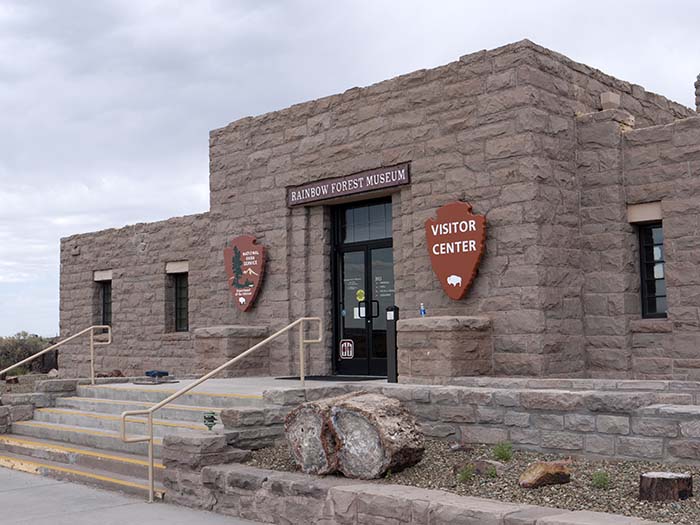
Rainbow Forest Museum
August 9, 2016: 9:52 AM |

(Machaeroprosopus mccaulyi)
Phytosauria (order) Phytosauridae (family) August 9, 2016: 8:40 AM |
|
This is the largest phytosaur skull that has ever been found in the Park. It is approximately 211 million years old. It was found in the Painted Desert in 1985 by the University of Colorado, and excavated by the New Mexico Museum of Natural History. Machaeroprosopus is Greek for knife-like face or appearance, which definitely describes this long snout. McCauley is the last name of the family that owned the land where it was found (now part of the Park).
The museum description |

Dimorphodon
Named by paleontologist Richard Owen in 1859. Pterosauria (order) Dimorphodontidae (family) August 9, 2016: 9:07 AM |
|
In 2011, paleontologists working in the park found the first evidence of pterosaurs, flying reptiles whose wing was comprised of one long finger and a flap of the skin. The evidence consists of one section of jaw bone, some isolated teeth, and a few other elements of the skeleton. The bones offer a tantalizing glimpse of what might be one of the oldest pterosaurs from North America. The cast skeleton currently mounted here is of Dimorphodon, a genus of pterosaur from the early Jurassic, which was probably similar in size and body shape to the Petrified Forest specimen.
The museum description |
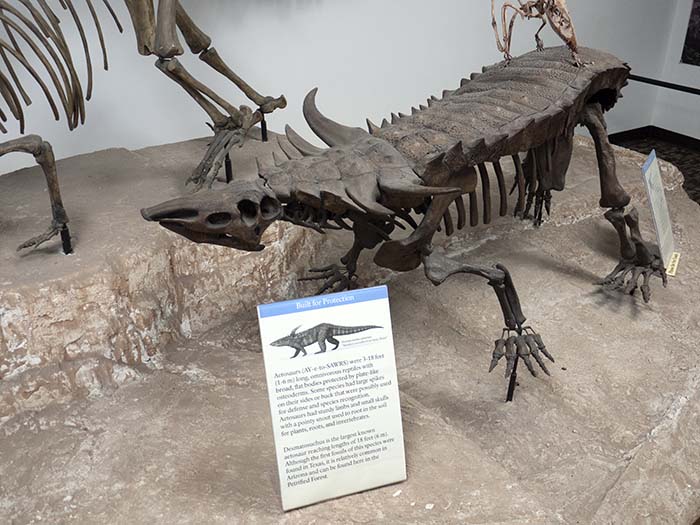
Desmatosuchus
Aetosauria (order) Stagonolepididae (family) August 9, 2016: 9:08 AM |
|
Aetosaurs were 3-18 feet (1-6 m) long, omnivorous reptiles with broad, flat bodies protected by plate-like osteoderms. Some species had large spikes on their sides or back that were possibly used for defense and species recognition. Aetosaurs had sturdy limbs and small skulls with a pointy snout used to root in the soil for plants, roots, and invertebrates. Desmatosuchus is the largest known aetosaur reaching lengths of 18 feet (6 m). Although the first fossils of this species were found in Texas, it is relatively common in Arizona and can be found in the Petrified Forest.
The museum description |
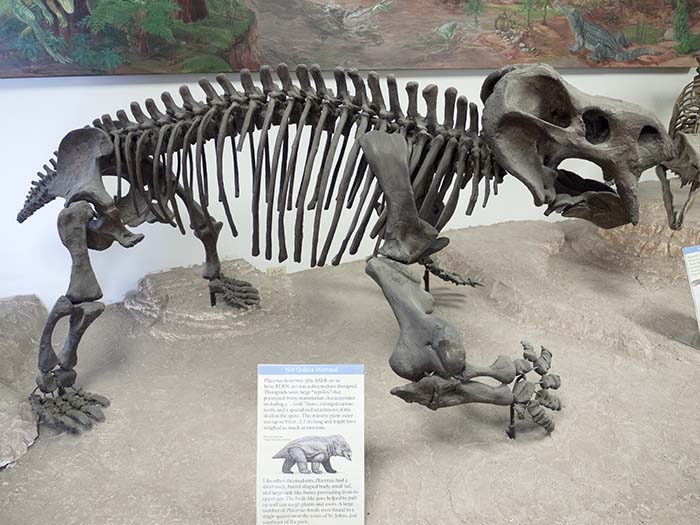
Placerias hesternus
Therapsida (order) Stahleckeriidae (family) August 9, 2016: 9:09 AM |
|
Placerias hesternus was a dicynodont therapsid. Therapsids were large "reptiles" that possessed many mammalian characteristics, including a "cheek" bone, enlarged canine teeth, and a specialized attachment of the skull to the spine. This massive plant-eater was up to 9 feet (2.7 m) long and might have weighed as much as two tons.
The museum description |
|
Placerias has been called a "reptilian hippo" because of its similar body shape and weight. Over 40 Placerias skeletons have been unearthed in Petrified Forest National Park.
Prehistoric Life |
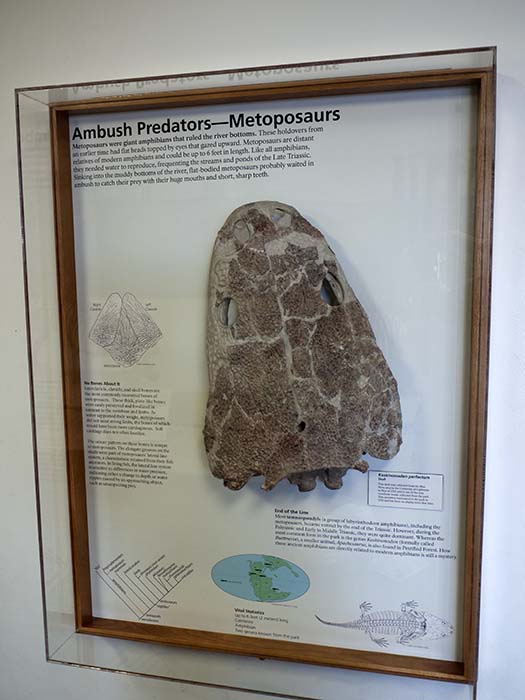
Koskinonodon perfectum
Temnospondyli (order) Metoposauridae (family) August 9, 2016: 9:13 AM |
|
Metoposaurs were giant amphibians that ruled the river bottoms. These holdovers from an earlier time had flat heads topped by eyes that gazed upward. Metoposaurs are distant relatives of modern amphibians and could be up to 6 feet (2 m) in length. Like all amphibians, they needed water to reproduce, frequenting the streams and ponds of the Late Triassic. Sinking into the muddy bottoms of the river, flat-bodied metoposaurs probably waited in ambush to catch their prey with their huge mouths and short, sharp teeth.
Interclavicle, clavicle, and skull bones are the most commonly recovered bones of metoposaurs. These thick, plate-like bones were easily preserved and fossilized, in contrast to the vertebrae and limbs. As water supported their weight, metoposaurs did not need strong limbs, the bones of which would have been more cartilaginous. Soft cartilage does not often fossilize. The ornate pattern on these bones is unique to metoposaurs. The elongate grooves on the skulls were part of metoposaurs' lateral line system, a characteristic retained from their fish ancestors. In living fish, the lateral line system is sensitive to differences in water pressure, indicating either a change in depth or water ripples caused by an approaching object, such as unsuspecting prey. Most temnospondyls (a group of labyrinthodont amphibians), including the metoposaurs, became extinct by the end of the Triassic. However, during the Paleozoic and Early to Middle Triassic, they were quite dominant. Whereas the most common form in the park is the genus Koskinonodon (formerly called Buettneria), a smaller animal, Apachesaurus, is also found in Petrified Forest. This Koskinonodon perfectum skull was collected from the Blue Mesa area by the University of California in May of 1921 and is one of the first vertebrate fossils collected from the park. This specimen was loaned to the park in 1932 and has been on display since that time. The museum description |

Enoploclytia porteri
Decapoda (order) Erymidae (family) August 9, 2016: 9:16 AM |
|
You would be hard pressed to pull a crayfish out of the Rio Puerco today, but this fossil shows that crayfish did live in the Triassic river system. This fossilized crayfish must be shown only as a photo because the real specimen is too unique to display. It is the earliest known occurrence of a crayfish in the world and the only known example of its species.
The museum description |

The Petrified Forest
August 9, 2016: 9:29 AM |
|
During the Late Triassic, America was several thousand miles southeast of its present location and much closer to the equator than it is now. As a result, ancient Arizona was then about the latitude of Panama but at a position that is now in the middle of the Atlantic Ocean, about halfway between South America and Africa. At that time, North America had just separated from western Africa and South America and had begun drifting northwestwardly toward its present location. Thus, much of the continent was then in the tropics.
In the Late Triassic, northeastern Arizona was a plain with rather low relief. South and southeast of the plain in what is now southern Arizona and New Mexico, there was a chain of mountains sometimes called the Mogollon Highlands. To the west, the sea was present in the region of modern-day southern California and western Nevada. Many streams that had their haedwaters in the Mogollon Highlands meandered northwestwardly across the plain on their way to the sea. These streams carried sediment from the highlands and deposited it in the stream channels and on floodplains. Between the streams were low hills, swamps, and small lakes. The climate was warm and moist, and the land was covered with many types of vegetation such as ferns, horsetails, conifers, and cycads. Petrified Forest: A Story in Stone by Sidney Ash |
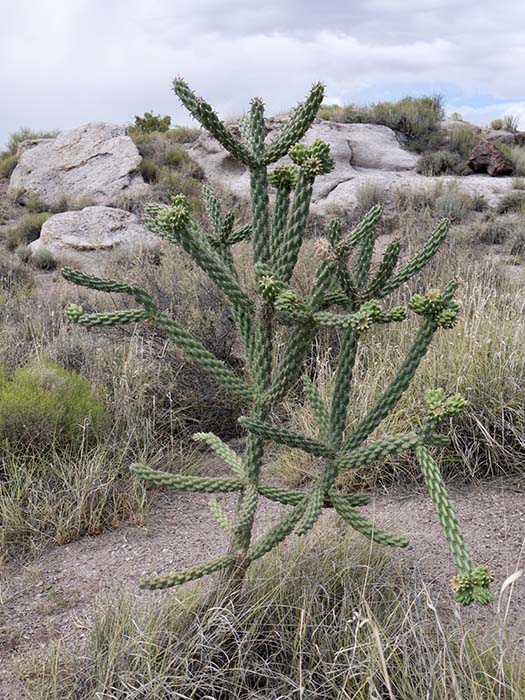
A tree cholla (Cylidropuntia imbricata)
August 9, 2016: 9:33 AM |
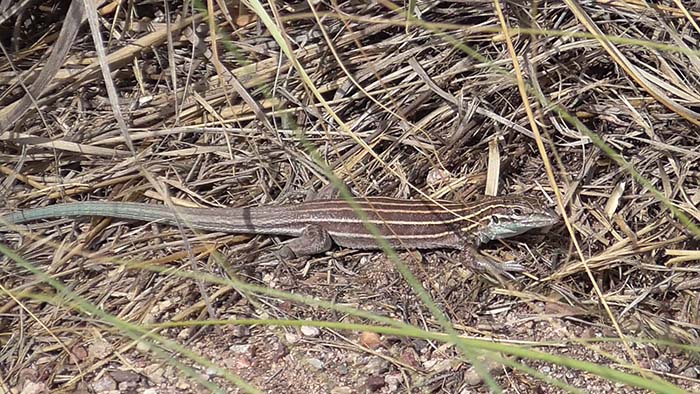
A plateau striped whiptail (Aspidoscelis velox)
August 9, 2016 |
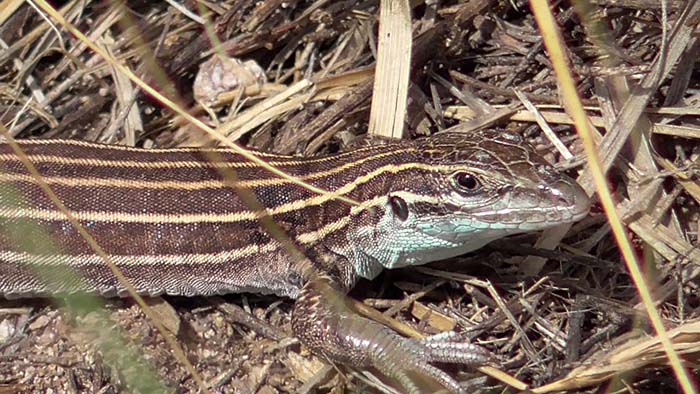
A plateau striped whiptail (Aspidoscelis velox)
August 9, 2016 |

A petrified log
August 9, 2016: 9:39 AM |
|
Petrified wood in the park is primarily from Araucarioxylon arizonicum, a conifer species associated with the Chinle Formation (Late Triassic).
|
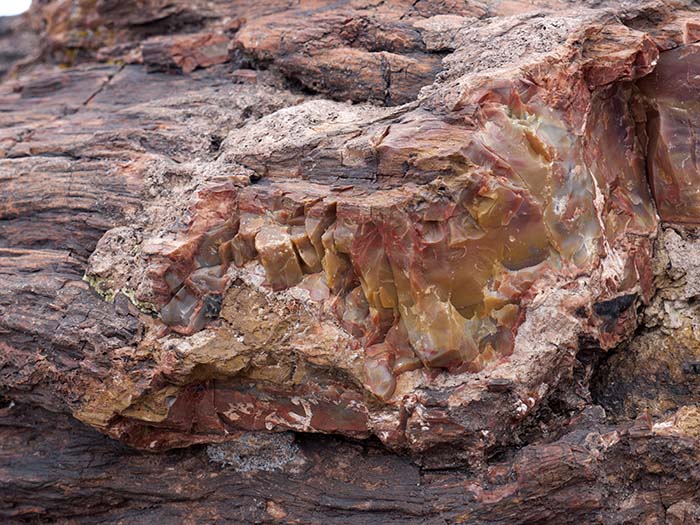
Petrified wood
August 9, 2016: 9:39 AM |
|
Several types of fossilization are represented in the Petrified Forest. The main type of fossilization is petrification, where wood and bones are turned to stone. Two types of petrification are found in the park.
In the first type, all or practically all of the organic matter in potential fossils was replaced by mineral matter. The resulting fossil has the external form of the object but little or none of the internal cellular structure is still present. In the Petrified Forest, most of the logs have been replaced at least in part by mineral matter, especially varieties of quartz, and they now contain little, if any, of the original organic matter. In the second type of petrification, the cells and other spaces in the potential fossil are filled with mineral matter, but much of the original organic matter remains unchanged. In this type of petrification, or permineralization, much of the cellular detail in the fossil is preserved and can be observed with a microscope. Only a small proportion of the logs and stumps in the park have been permineralized, whereas most of the bones have been preserved in this manner. Petrified Forest: A Story in Stone by Sidney Ash |
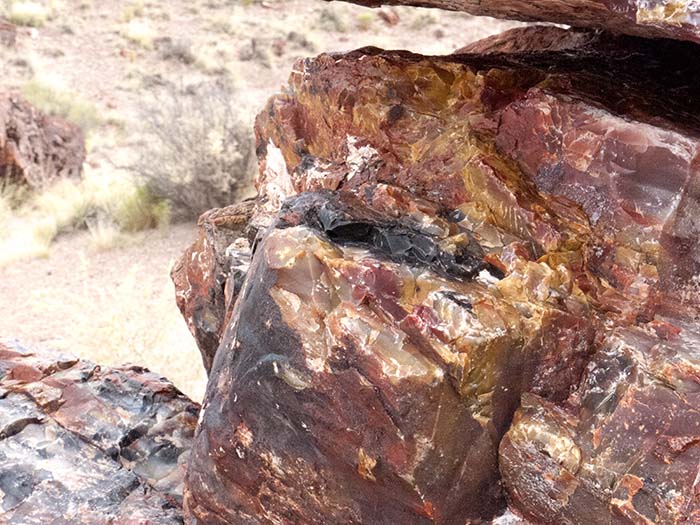
Petrified wood
August 9, 2016: 9:41 AM |
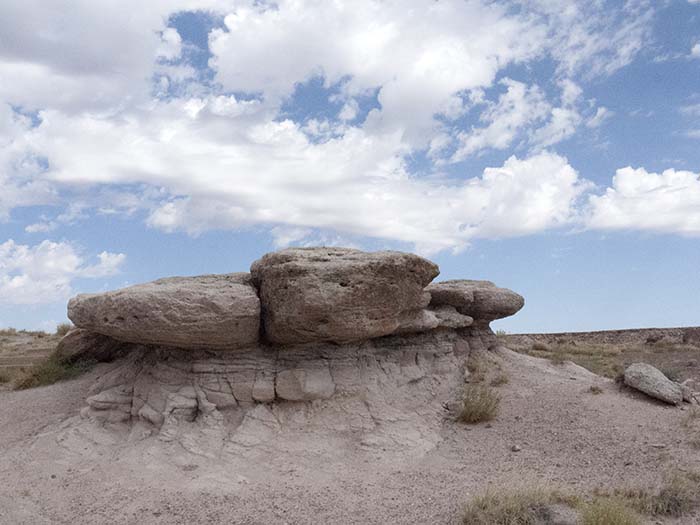
The Petrified Forest
August 9, 2016: 9:43 AM |
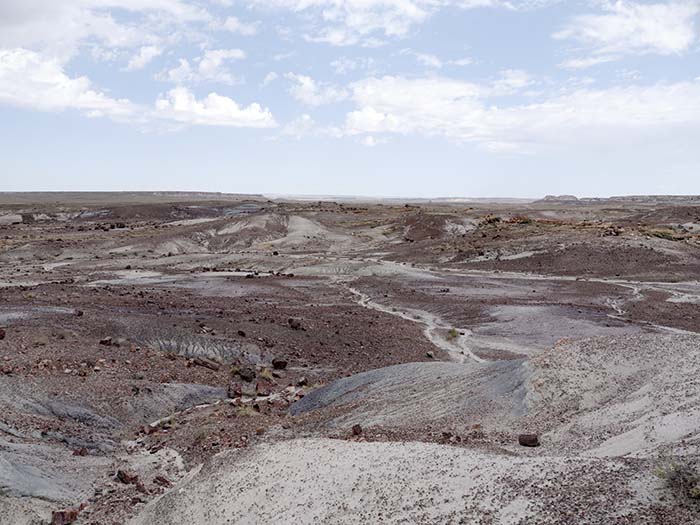
The Petrified Forest
August 9, 2016: 10:13 AM |

The Petrified Forest
August 9, 2016: 10:15 AM |
|
Conical hills are typically composed of relatively soft mudstone in the Chinle Formation. The dendritic pattern on their surface has been formed by running water from rain and melting snow.
Petrified Forest: A Story in Stone by Sidney Ash |
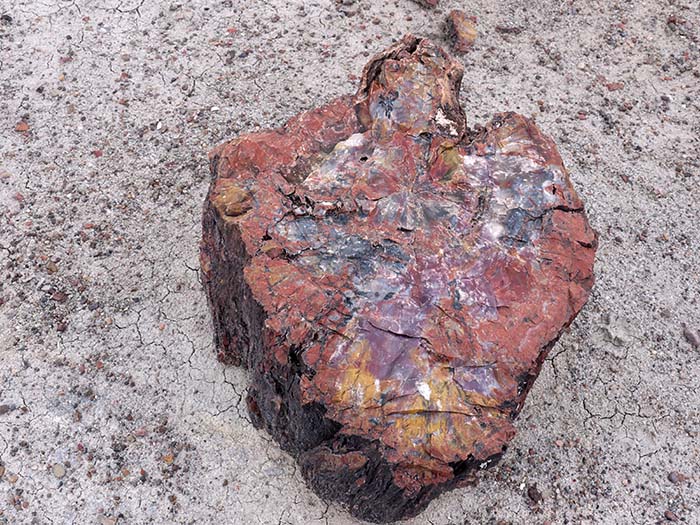
Petrified wood
August 9, 2016: 10:28 AM |
|
The red colors in petrified wood are a result of small amounts of iron minerals mixed with the mineral quartz, which is normally colorless.
Petrified Forest: A Story in Stone by Sidney Ash |

The Petrified Forest
August 9, 2016: 10:52 AM |
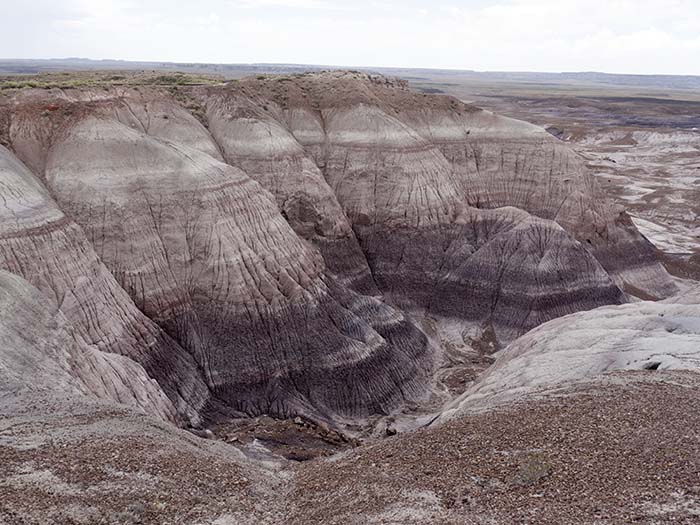
The Petrified Forest
August 9, 2016: 10:53 AM |
|
Various combinations of minerals and other substances in the Chinle provide tones that seem to encompass all shades of the rainbow. For example, iron oxides in varying amounts are responsible for the wide range of red tones in the Painted Desert and elsewhere in this formation. Decayed plant and animal matter usually contribute to the gray color found in the Chinle. The white coloring in the prominent but thin layer of rock in the Painted Desert north of Kachina Point is due to volcanic ash. This distinctive layer is incongruently called the Black Forest Bed because it contains the large concentration of black logs called the Black Forest.
Petrified Forest: A Story in Stone by Sidney Ash |
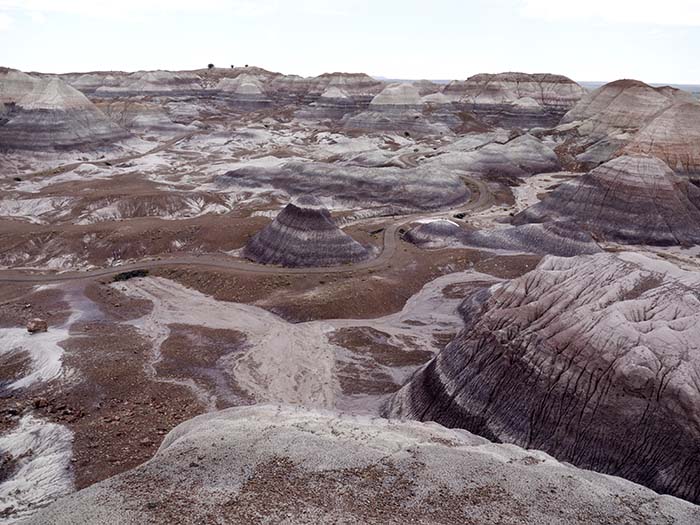
The Petrified Forest
August 9, 2016: 10:54 AM |
|
When exposed to forces of erosion for a short time, the Chinle Formation usually develops into badlands. Sandstone and conglomerate resist erosion, forming cliffs and fostering the development of mesas (broad flat-topped hills), such as Blue Mesa and buttes (small flat-topped hills) like the Haystacks. When the protective layers of hard sandstone and conglomerate are removed, the softer beds of shale and mudstone erode much more rapidly and tend to produce sloping hillsides and narrow gullies. Consequently, the soft beds form conical hills and mounds instead of flat-topped features.
Petrified Forest: A Story in Stone by Sidney Ash |
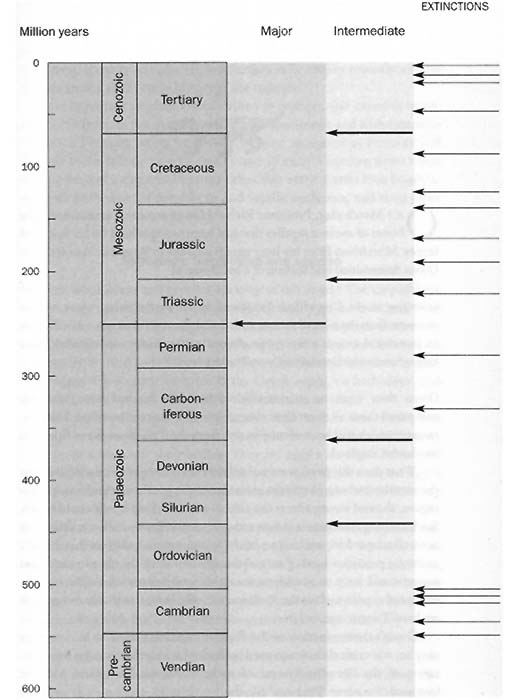
Mass extinctions and minor extinctions
When Life Nearly Died: The Greatest Mass Extinction of All Time by Michael J. Benton |
|
A catastrophic event at the end of the Permian period (around 251 million years ago) wiped out nearly all species on Earth. The Triassic species represented in the Petrified Forest are descendants of life forms that have squeezed through this narrow bottleneck. The Permian extinction ushered in the age of the dinosaurs (which ended with another extinction 65 million years ago) and delayed the rise of the mammals. We humans are a byproduct of these processes.
|

Rocks with pre-Columbian petroglyphs
August 9, 2016: 11:11 AM |
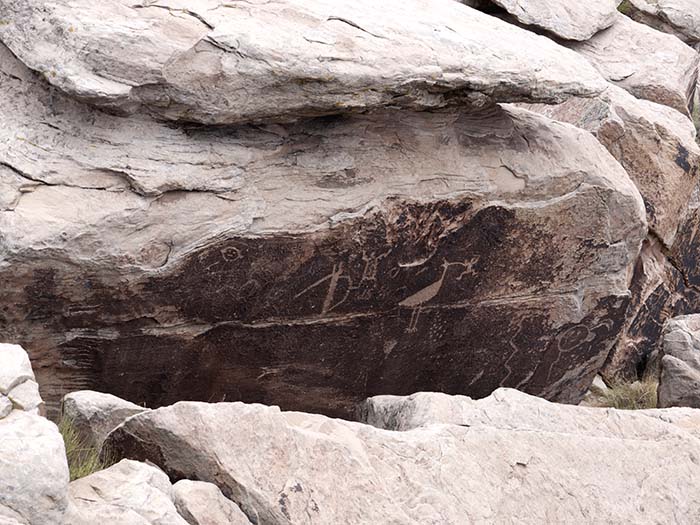
Pre-Columbian petroglyphs
August 9, 2016: 11:37 AM |
|
It is not possible to determine the age of individual petroglyphs. The rate at which desert varnish develops depends upon so many variables that it is of no use in measuring time. However, petroglyphs vary in clarity, so it is obvious that they also vary somewhat in age. In some cases, newer petroglyphs partially obscure older ones. Possibly a design or a figure made at one time may be adjacent to one made several years later, yet it appears to be of similar age. Different individuals representing different cultures could have made two petroglyphs of the same age. And in other situations one artist may well have decided to "improve" the work of another.
Petrified Forest: A Story in Stone by Sidney Ash |

Pre-Columbian petroglyphs
August 9, 2016 |
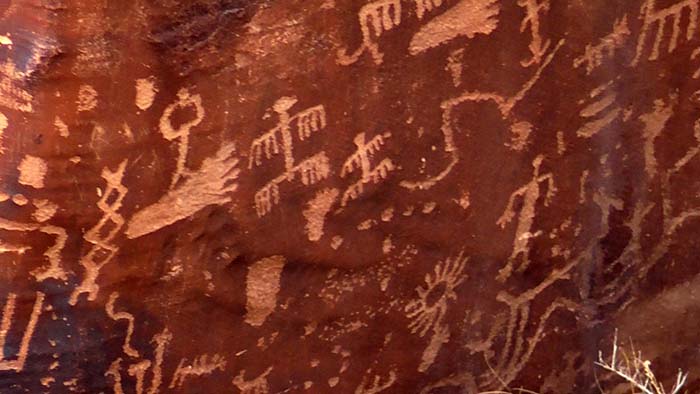
Pre-Columbian petroglyphs
August 9, 2016 |
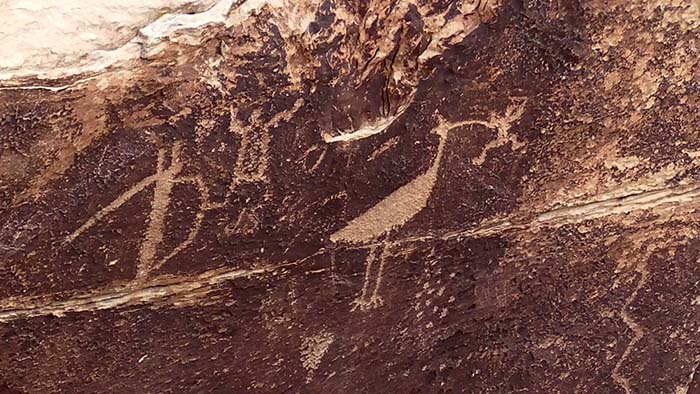
Pre-Columbian petroglyphs
August 9, 2016 |

The Petrified Forest
August 9, 2016: 11:52 AM |

A mural by Fred Kabotie (1900–1986)
Painted Desert Inn August 9, 2016: 12:04 PM |
|
This mural tells a story about two brothers who set off on a long and arduous journey to bring water to their village. The journey takes many months and is both physical and spiritual. Note the size of the figures when they depart and return.
|
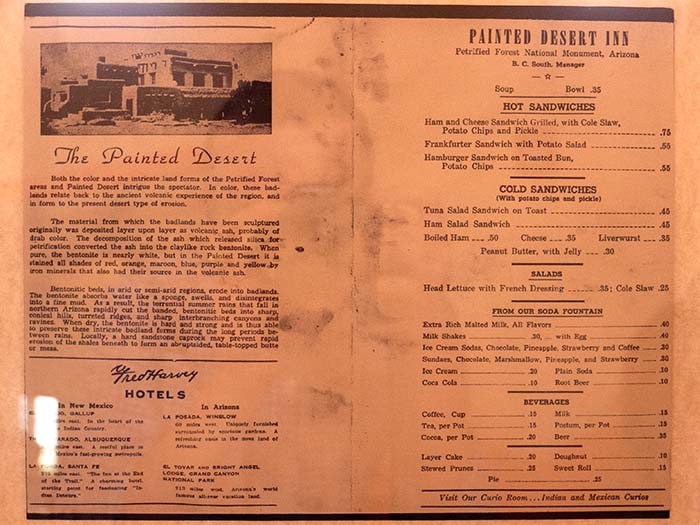
Painted Desert Inn: A look back
August 9, 2016: 12:05 PM |

Painted Desert Inn: A look back
August 9, 2016: 12:06 PM |
|
Having grown increasingly dissatisfied with his meals and accommodations while traveling, railroad man Fred Harvey set to revolutionize the hospitality industry. Beginning in Kansas in 1876, Harvey Houses were popping up all along the Santa Fe Railroad line. Over time, the name Fred Harvey became synonymous with comfort and quality. The company's lead architect and interior designer Mary Jane Elizabeth Colter gave the facilities grandeur, class, and cohesion with their Southwestern environments. When the Fred Harvey Company took over operations of the Painted Desert Inn in 1947, Colter quickly set to work to update and enliven the place. Along with renovations and repair, Colter designed the bright color scheme and new windows to take advantage of the magnificent views. Another accomplishment was hiring renowned Hopi artist Fred Kabotie to paint murals on the dining room and lunchroom walls. Colter and Kabotie had worked together previously on her buildings at the Grand Canyon.
Painted Desert Inn |
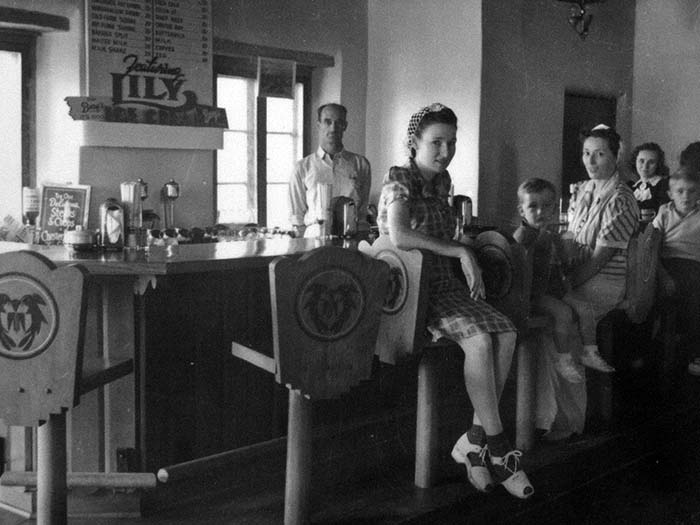
Painted Desert Inn (a digitally restored photograph for this webpage)
August 9, 2016: 12:06 PM |
|
In 2017, a major revision of dinosaur relationships was proposed based on a computational analysis.
|